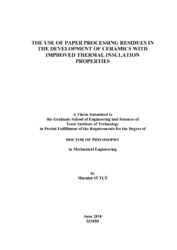Please use this identifier to cite or link to this item:
https://hdl.handle.net/11147/2936Full metadata record
| DC Field | Value | Language |
|---|---|---|
| dc.contributor.advisor | Akkurt, Sedat | - |
| dc.contributor.author | Sütçü, Mücahit | - |
| dc.date.accessioned | 2014-07-22T13:48:38Z | - |
| dc.date.available | 2014-07-22T13:48:38Z | - |
| dc.date.issued | 2010 | - |
| dc.identifier.uri | http://hdl.handle.net/11147/2936 | - |
| dc.description | Thesis (Doctoral)--Izmir Institute of Technology, Mechanical Engineering, Izmir, 2010 | en_US |
| dc.description | Includes bibliographical references (leaves: 154-165) | en_US |
| dc.description | Text in English; Abstract: Turkish and English | en_US |
| dc.description | xvii, 165, leaves | en_US |
| dc.description.abstract | Recycled paper processing residues, those are industrial wastes, are utilized in the manufacture of porous and lightweight ceramics with improved thermal insulation properties for structural brick and refractory firebrick applications. These residues that contained micro-sized calcium carbonate (<5 .m) and cellulose fibers (<20 .m of diameter), were successfully used as an additive to earthenware brick to create porous structure during firing. A solid porous brick and a vertically perforated porous brick had 0.4 W/mK and 0.158 W/mK of thermal conductivity, respectively. This means substantial potential energy savings in houses and other buildings. When the paper residue was added in extreme amounts to the brick clay, it was found that anorthite (CaO.Al2O3.2SiO2) formed in the brick at the high-end of the firing temperatures of 1000-1100 C. This inspired the second part of the thesis which dealt with the production of porous, lower density insulating firebrick. Addition of the paper residue in excessive amounts up to 30% into the clay systems and firing at higher temperatures (1100.1400 C) formed a crystalline anorthite phase. Highly porous anorthite lightweight ceramics from the mixtures with up to 30% sawdust addition (used as additional pore-former) was successfully produced. Thermal conductivities of the samples decreased from 0.25 W/mK (1.12 g/cm3) to 0.13 W/mK (0.64 g/cm3) with increasing sawdust addition. Samples were stable at high temperatures up to 1100 C, and their cold strength was sufficiently high. Two separate porous lightweight ceramics were developed for insulation in buildings to reduce heat losses, and for insulation in high temperature applications. | en_US |
| dc.language.iso | en | en_US |
| dc.publisher | Izmir Institute of Technology | en_US |
| dc.rights | info:eu-repo/semantics/openAccess | en_US |
| dc.subject.lcsh | Ceramic materials | en |
| dc.subject.lcsh | Waste paper--Recycling | en |
| dc.subject.lcsh | Insulation (Heat) | en |
| dc.subject.lcsh | Waste products as building materials | en |
| dc.title | The Use of Paper Processing Residues in the Development of Ceramics With Improved Thermal Insulation Properties | en_US |
| dc.type | Doctoral Thesis | en_US |
| dc.department | Thesis (Doctoral)--İzmir Institute of Technology, Mechanical Engineering | en_US |
| dc.relation.publicationcategory | Tez | en_US |
| dc.identifier.wosquality | N/A | - |
| dc.identifier.scopusquality | N/A | - |
| item.openairecristype | http://purl.org/coar/resource_type/c_18cf | - |
| item.languageiso639-1 | en | - |
| item.openairetype | Doctoral Thesis | - |
| item.grantfulltext | open | - |
| item.fulltext | With Fulltext | - |
| item.cerifentitytype | Publications | - |
| Appears in Collections: | Phd Degree / Doktora | |
Files in This Item:
| File | Description | Size | Format | |
|---|---|---|---|---|
| T000834.pdf | DoctoralThesis | 43.3 MB | Adobe PDF |  View/Open |
CORE Recommender
Sorry the service is unavailable at the moment. Please try again later.
Items in GCRIS Repository are protected by copyright, with all rights reserved, unless otherwise indicated.